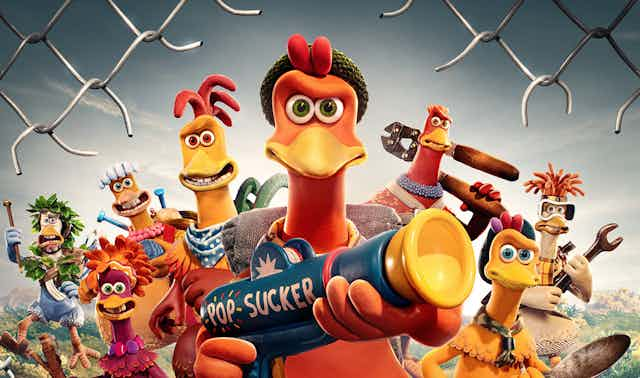Chicken Run 2: Dawn of the Nugget combines the distinctive charm of the Great Escape-esque story that characterised the original Chicken Run (2000), with an action-packed plot, staged in a futuristic setting fit for the 21st century.
Picking the story up from where the original Chicken Run ended, this time the plot is inspired by Mission Impossible (1996) and James Bond – a caper film that sees the chicken protagonists breaking in, rather than breaking out.
Protagonists Ginger (Thandiwe Newton) and Rocky (Zachary Levi) are now parents to the runaway teenage chick Molly (Bella Ramsey), who ends up in the clutches of her parents’ arch nemesis, Mrs Tweedy (Miranda Richardson).
Tweedy has received a “glamorous make-over” for the sequel, while her chicken farm has been replaced with a futuristic chicken fun land – a compound that serves the meat-hungry food industry an assembly line of poultry.
Trying to save their daughter from becoming a chicken nugget, Rocky, Ginger and their fellow chickens venture to break into this high-tech bastion. With appealing new characters, emotional depth and distinctly British humour, this fast-paced slapstick extravaganza is both a technical and artistic achievement.
Changes since Chicken Run
Since being founded by Peter Lord and David Sproxton in 1972, Bristol-based studio Aardman Animation has been a global player in stop motion animation. From its Oscar-winning films Creature Comforts (1990), The Wrong Trousers (1993) and A Close Shave (1995) to its first ever feature film, Chicken Run, Aardman’s story is one of unrivalled success.
Read more: The Wrong Trousers: why the Wallace and Gromit animation is still a family favourite 30 years later
The first Chicken Run set new standards, not only breaking records for audience reach, and global box-office profit, but also for its technical prowess. During production, 30 sets were used with 18 animators. This sequel is no less ambitious in its technical scope.
The original Chicken Run was shot with mounted film cameras, which meant that the Aardman team did not know the final look before the development process had completed. Since 2005, stop-motion features have predominantly adopted digital cameras.
In this sense, Chicken Run was a historic milestone, as there is no evidence of any cleanup work in post-production. This means practically everything that the audience sees happened right in front of the camera.
Today, many stop motion animation productions, both big and small, are using visual effects to tidy up mistakes, make the scope and breadth of sets larger and clean up puppet rigs. This became a huge benefit to the new production in terms of keeping the consistency and coherence of the physical scale difference between chickens and human.
For Chicken Run: Dawn of the Nugget, a team of 30 animators and 45 units – led by lead animator Will Becher and director Sam Fell – paid particular attention to facial expressions, eye movement and newly adapted mouth features to augment the original character designs.
Due to the many diverse measures of unit within the film, the set designers, supervised by art director Matt Perry, focused on scaling, proportions and dimensions. These presented the team with unprecedented technical challenges (architectural, human, and chicken) which had a direct impact on lighting and compositions.
Challenges for the animators
Whereas the original Chicken Run was set on a farm, Dawn of the Nugget takes place in a quintessentially human environment – the James Bond-inspired Fun-Land compound.
Part of this fortress-come-factory consists of a playground for chickens, with its own distinctive psychedelic colour palette. This environment is created at chicken-scale, while the control station and factory environment remain human-scaled. Consolidating and integrating these different dimensions into a coherent and consistent aesthetic, with sophisticated lighting and art direction, involved advanced hand-animation skills, as well as a degree of post-production to ensure lighting consistency.

Visual effects production for Dawn of the Nugget had to strike a balance between cleaning up and maintaining a characteristic hand-crafted, tactile style. Kirstie Deane, VFX producer, explains in the behind the scenes film that their team “cleaned-up elements” that are a bit distracting, but for the most part, all of those thumb prints and the hand-touched nature of the stop-frame remained untouched.
The fine balance between the physical and human nature of Aardman animation, and the need for rudimentary post-production to further film consistency and continuity, contributes to Dawn of the Nugget’s unique charm.
With its thinly veiled capitalist critique, the film manages to successfully lift the storyline into the 21st century, while maintaining a fluid, organic, yet tactile feel. Animated on every second frame, the film presents audiences with a dynamic visual rollercoaster of hand-animation, that never feels over-produced, but manages to instil its dialogue, characters and actions with an endearing comedy.

While the original Chicken Run was both critically acclaimed for its lead female role, it was also criticised for its stereotyped depiction of gendered activities, such as knitting and sewing.
The sequel has learned from the past. It centres around another strong-willed female protagonist – teenage chick Molly – and her strong relationship with the gender-fluid Frizzel reaches beyond gender stereotypes.
Chicken Run: Dawn of the Nugget is a visually captivating firework of handcraft and skill in stop motion. It’s a labour of love, that points as much to the past as to the future of the animation industry. The film builds on the core strengths of Aardman Animations. It features appealing character design, world-leading stop motion clay animation and a masterclass in British wit and humour.

Looking for something good? Cut through the noise with a carefully curated selection of the latest releases, live events and exhibitions, straight to your inbox every fortnight, on Fridays. Sign up here.

